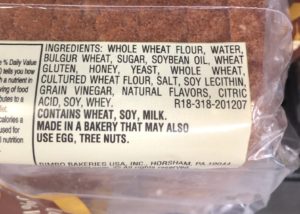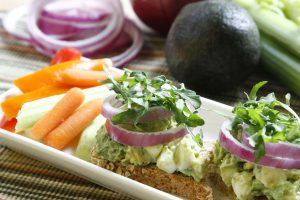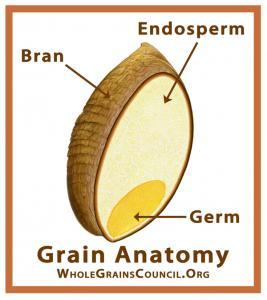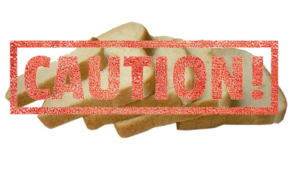 Do you feel like you need a chemistry degree to purchase a healthy and nutritious bread at the store?
Do you feel like you need a chemistry degree to purchase a healthy and nutritious bread at the store?
If you have recently evaluated the options in the bread aisle, it just may leave your head spinning!
In Michael Pollan’s book “Food Rules,” he says “the whiter the bread, the sooner you’ll be dead,” making the point that, as far as our bodies are concerned, enriched white flour is not much different than sugar. So, our grandmothers, who lived by the rule of eating whole grains, were right…this is one of many rules to live by for a healthier and longer life.
So, how do we cut through the confusion of the bread aisle?
And, how are we supposed to know what breads contain whole grains (and are good for us) and those that do not? Here is what you should look for:
- A “whole” grain as the first ingredient.
- Ignore the claims and “healthy catch phrases” on the package.
- Read the ingredients — look for an ingredient list that is short and recognizable.
The most important word to look for!
 When reading the label, look for a whole grain as the first ingredient (it has to have the word “whole” in it…items like 100% whole wheat, whole wheat flour, whole grain rye flour, etc.).
When reading the label, look for a whole grain as the first ingredient (it has to have the word “whole” in it…items like 100% whole wheat, whole wheat flour, whole grain rye flour, etc.).
Be on the lookout for ingredients such as wheat flour, unbleached wheat flour, multigrain, enriched or stone-ground wheat flour. These are all sneaky ways to say that the wheat has been refined (meaning the once-healthy grain has been taken apart through processing), and therefore it is NOT 100% whole wheat. While multigrain sounds healthy, this simply means that the bread contains more than one type of grain – although none of them may be whole grains.
Why are whole grains important?
 Let’s face it, breads often become a villain when it comes to healthy eating. The great news is there is no reason to give up bread!
Let’s face it, breads often become a villain when it comes to healthy eating. The great news is there is no reason to give up bread!
Yes, it is true, many breads are nutritionally deficient and not much different than sugar…just like Michael Pollan said. However, it is also true that whole grains are an incredibly important part of a healthy diet. Many whole grain breads provide 2-3 grams of fiber and 3-5 grams of protein per slice. So, it can actually be beneficial to enjoy a slice or two of whole grain bread as part of your REAL food lifestyle.
 Consider serving sandwiches open-faced to help you not go overboard — here are a few ideas, and we have many more you should try!
Consider serving sandwiches open-faced to help you not go overboard — here are a few ideas, and we have many more you should try!
 Without going too deep into the science of whole grains vs. processed grains, here’s the deal: grains are made up of three parts…the bran, the germ and the endosperm.
Without going too deep into the science of whole grains vs. processed grains, here’s the deal: grains are made up of three parts…the bran, the germ and the endosperm.
The majority of the fiber and nutrients are found in the bran and the germ. With whole grain breads, all three parts of the grain are left intact. But when grains are further refined, the bran and germ are removed, leaving only the endosperm, which is low in vitamins and minerals. This is what happens when white breads and other refined breads are made.
To make up for the nutrients being removed, these refined breads are often “enriched.” The word “enriched” should send off alarm bells, as it is an indicator that the healthy parts of the grain have been removed. The nutrients that are added back to “enrich” the bread are often synthetic and aren’t the same as the nutrients found in the whole grains. Check out our coaching tip on flours and whole grains for more info!
Know what you are getting and read the ingredient label!
Remember, when it comes to the list of ingredients, the shorter the better. All you really need to make bread is flour, water, yeast and salt. That’s it! Unfortunately, many breads contain a long list of ingredients that include additives, preservatives and sweeteners to lengthen shelf life, make them taste sweeter, change the color or texture, or add vitamins or minerals back in.
What about sprouted grains?
 You may have heard of a whole grain bread called Ezekiel (made by Food for Life), which can be found in the frozen section of many stores. Ezekiel is actually made from sprouted grains.
You may have heard of a whole grain bread called Ezekiel (made by Food for Life), which can be found in the frozen section of many stores. Ezekiel is actually made from sprouted grains.
While whole grains are the seeds of plants before they germinate, sprouted grains are allowed to germinate just a bit. Some believe sprouted grains are easier to digest, higher in nutrients and lower in “antinutrients.” The reality is these differences are likely small vs. whole grains. So, while there may be a slight benefit to sprouted grains, whole grains are also a perfectly good option.
Another benefit of Food for Life breads is there are no preservatives or refined sugars (which is why the bread is sold frozen instead of from the bread aisle). It will generally stay good in the refrigerator for a couple weeks, but should otherwise stay frozen.
We like using the Ezekiel cinnamon raisin bread to make a great Cinnamon Raisin French Toast Bake.
Find your favorite!
In our REAL food journey, we reached a point where we decided to buy only whole grain products for our bread, hamburger buns, pasta and more. It took a little time for our kids to adjust to this concept. At first, they could detect these whole grains so fast…there was no tricking them. But they eventually began to prefer these foods. There are still some whole grain breads they are not big fans of. Like anything, it is a matter of finding the ones that you and your family like.
Remember, look for a “whole” grain as the first ingredient and a short ingredient list!
Do you have other tips for buying bread? If so, please share with us!
 LEARN MORE ABOUT THE NAPKIN!
LEARN MORE ABOUT THE NAPKIN!

The whole grain VS sprouted is interesting. Thank you.